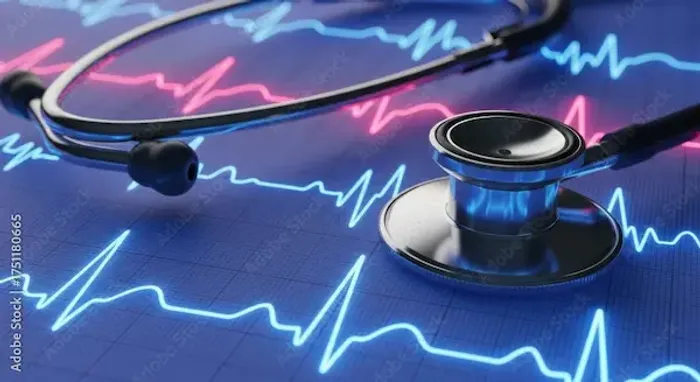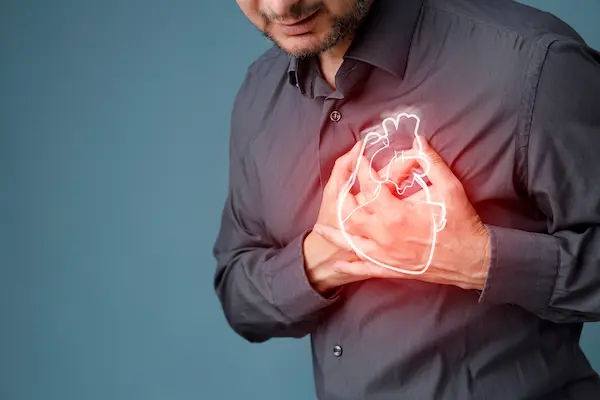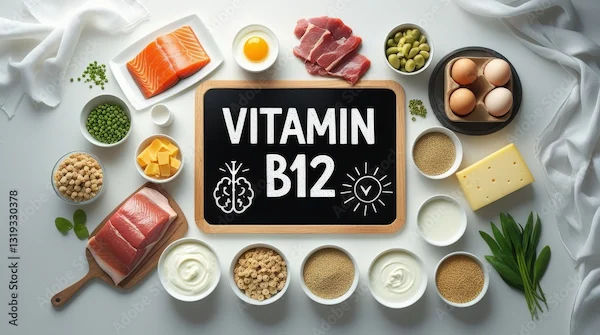Guide to Normal Vs Dangerous Heart Rate
Learn the difference between a normal heart rate and a dangerously high or low one. Discover healthy resting heart rate ranges, when to worry, and what to do if your heart rate is concerning. Stay safe!

Written by Dr. Md Yusuf Shareef
Reviewed by Dr. Rohinipriyanka Pondugula MBBS
Last updated on 29th Oct, 2025

Introduction
Your heart rate is one of the simplest windows into your health. But what counts as a normal heart rate, and when does it become dangerous? In this guide, we break down normal vs dangerous heart rate ranges, how they change with age, fitness, and activity, and what symptoms to watch for. You’ll learn how to check your pulse accurately, understand common causes for high or low heart rates, and know when it’s time to seek care. We’ll also cover safe exercise zones, special situations like fever and pregnancy, and how wearables can help you monitor your heart. By the end, you’ll have a clear, practical plan for tracking your heart and recognizing dangerous patterns early.
Heart Rate 101: What it is and why it matters
Your heart rate is the number of times your heart beats per minute (bpm). It changes constantly—rising with activity or stress and falling during rest and sleep. A healthy heart rate reflects how efficiently your heart pumps blood and oxygen to your body.
Resting vs active heart rate
- Resting heart rate (RHR) is measured when you’re relaxed, not exercising, and usually after sitting or lying quietly for a few minutes. In most adults, a normal resting heart rate falls between 60 and 100 bpm, though fit individuals may sit lower.
- Active heart rate increases with movement, stress, illness, and temperature. It’s normal to see 120–160 bpm during vigorous exercise, depending on age and fitness.
Heart rate vs heart rhythm
- Heart rate is the speed; rhythm is the pattern. A normal rhythm (sinus rhythm) is regular and steady. Irregular rhythms (arrhythmias) like atrial fibrillation (AFib) can cause an uneven pulse or sudden jumps in rate. A normal rate can still be dangerous if the rhythm is abnormal, and a high rate can occasionally be benign if the rhythm is normal and the context explains it (e.g., sprinting).
How is heart rate measured?
- Manual pulse: Use two fingers (not your thumb) on the radial artery (wrist) or carotid artery (neck). Count beats for 30 seconds and double for bpm.
- Devices: Optical sensors in smartwatches/fitness trackers estimate heart rate via blood flow changes. Chest straps detect
electrical signals (ECG) and are generally more accurate during intense activity. Some consumer devices can record
single-lead ECGs for rhythm checks.
Normal heart rate ranges by age, sex, and fitness
Adults and older adults
- Most adults: 60–100 bpm at rest; many healthy adults fall in the 55–85 range.
- Older adults may have slightly higher resting rates due to deconditioning or medications. Persistently elevated resting
heart rate (e.g., >80–85) has been associated with higher cardiovascular risk over time, especially alongside other risk
factors.
Children and teens
Heart rates are faster in younger children and gradually slow with age. Typical resting ranges:
- Newborns: 100–160 bpm
- Infants (1–12 months): 100–150 bpm
- Toddlers (1–3 years): 90–140 bpm
- Preschool (3–5): 80–120 bpm
- School-age (6–12): 70–110 bpm
- Teens (13–18): 60–100 bpm
Always interpret pediatric rates alongside behavior, fever, hydration, and activity level.
Athletes and very fit individuals
- Athlete resting heart rate: 40–60 bpm is common due to increased stroke volume and parasympathetic tone. A very low rate in an athlete without symptoms is usually normal, not dangerous.
- If a non-athlete has a persistent resting rate <50 bpm and symptoms (dizziness, fainting), it’s more concerning.
Sleep, stress, and circadian effects
- During deep sleep, heart rate often drops 10–20% below daytime resting levels.
- Acute stress or anxiety can temporarily raise heart rate by 10–30 bpm via adrenaline.
- Fever typically raises the heart rate by about 10 bpm per 1°C (1.8°F) increase in body temperature.
What counts as a dangerous heart rate? Red flags and thresholds
High heart rate (tachycardia) at rest
- In adults, a resting heart rate consistently above 100 bpm is called tachycardia. Brief spikes can be normal (e.g., after
caffeine or climbing stairs), but persistent elevations at rest warrant attention. - More concerning: >120 bpm at rest, especially with symptoms like chest pain, shortness of breath, fainting, or palpitations. Very fast, regular rates (150–220 bpm) may indicate supraventricular tachycardia (SVT), a rhythm that can start suddenly.
Low heart rate (bradycardia) at rest
- In adults, a resting heart rate below 60 bpm is bradycardia. This can be normal in athletes. It’s concerning if accompanied by symptoms like dizziness, fatigue, confusion, or syncope, or if the rate is <40 bpm at rest.
- During sleep, lower rates are expected; judged by daytime symptoms and wakeful measurements.
Symptoms that signal danger and when to seek urgent care?
- Call emergency services if you have chest pain/pressure, severe shortness of breath, fainting, confusion, or a heart rate >150 at rest or an irregular rhythm with severe symptoms.
- Seek prompt medical evaluation if your resting heart rate is persistently >100 or <50, or if you have palpitations, lightheadedness, or exercise intolerance. If symptoms persist beyond two weeks, consult a doctor online with Apollo 24|7 for further evaluation. They can help determine if you need an ECG, thyroid tests, electrolytes, or other diagnostics.
Why do heart rates go off track: common causes?
Everyday triggers
- Caffeine, energy drinks, nicotine: Stimulates the sympathetic nervous system, raising heart rate and sometimes causing palpitations.
- Dehydration: Reduces circulating volume, prompting the heart to beat faster to maintain blood pressure.
- Fever and infection: Raise heart rate; many illnesses also increase metabolic demand.
- Stress and anxiety: Adrenaline surges elevate heart rate; paced breathing can help.
Medical conditions
- Arrhythmias: AFib (irregularly irregular rhythm with variable rate), SVT (sudden-onset rapid, regular rhythm), atrial flutter, and ventricular arrhythmias. AFib often presents with an irregular pulse and fatigue.
- Thyroid disorders: Hyperthyroidism increases, and hypothyroidism can decrease heart rate.
- Anemia: Low hemoglobin forces the heart to beat faster to deliver oxygen.
- Lung conditions: Asthma exacerbations, pulmonary embolism can drive tachycardia.
- Infections and sepsis often cause an elevated heart rate, even before fever appears.
Medications and substances
- Increase HR: Decongestants (pseudoephedrine), certain asthma meds, stimulants (ADHD meds), excessive alcohol withdrawal.
- Decrease HR: Beta blockers, some calcium channel blockers, antiarrhythmics, and digoxin. Overmedication can cause bradycardia.
- If you have persisting abnormal rates, Apollo 24|7 offers convenient home collection for tests like TSH (thyroid), CBC (anemia), and electrolytes to help identify reversible causes.
How to check and track your heart rate accurately?
Manual pulse technique
- Sit quietly for 5 minutes. Place index and middle finger on your wrist (thumb side) or neck (side of windpipe). Count
beats for 30 seconds and double. - If the rhythm feels irregular, count the full 60 seconds and note irregularity to share with a clinician.
Fitness trackers, chest straps, and ECG devices
- Optical sensors (wrist wearables) are fairly accurate at rest and during steady exercise, but can misread during high-
intensity, arm-motion-heavy activities or with poor fit/skin perfusion. - Chest straps (electrical) are more accurate for rapid changes and high-intensity workouts.
- Some smartwatches can run a single-lead ECG and detect possible AFib. These are not diagnostic but useful screening
tools for atrial fibrillation heart rate irregularities. - Pro tip: Warm up your skin, ensure a snug fit, and wear the device higher on the wrist during exercise for better
readings.
Heart rate variability (HRV): what it can and can’t tell you?
- HRV measures the variation between beats, reflecting autonomic balance. Higher HRV generally suggests better
recovery and stress resilience. - Useful for training readiness and stress tracking, but day-to-day noise (sleep, alcohol, illness) can swing values. HRV is not a diagnostic test; treat it as a trend indicator, not a medical verdict.
What to do if your heart rate is too high or too low?
Immediate steps at home
- High heart rate at rest: Sit or lie down, hydrate, practice slow breathing (inhale 4 seconds, exhale 6–8 seconds), and
cool the room. Recheck after 10–15 minutes. - Low heart rate with symptoms: Sit or lie down; avoid driving; check blood sugar if diabetic; review recent medication
doses.
Vagal maneuvers and when to try them
- For sudden, regular, fast heartbeats (suspected SVT) without severe symptoms, a modified Valsalva maneuver (forceful
exhale against a closed airway, recline with leg raise) can sometimes restore normal rhythm; best performed after
instruction from a clinician. - Do not attempt if you have chest pain, severe shortness of breath, or known carotid disease—seek urgent care.
When to call a doctor vs go to the ER?
- Call a doctor (or consult Apollo 24|7 online) if resting HR is persistently >100 or <50, or if you have palpitations,
fatigue, or mild dizziness. If your condition does not improve after trying these methods, book a physical visit to a doctor with Apollo 24|7. - Go to the ER for chest pain, fainting, new severe shortness of breath, heart rate >150 at rest, or heart rate <40 with
symptoms. Long-tail keywords: when to go to ER for high heart rate, tachycardia vs bradycardia.
Exercise and safe heart rate zones
Maximum heart rate and training zones
A common estimate of maximum heart rate is 220 minus age, but individual variation is large. If you’re 40, the
estimated max is ~180 bpm, but your true max could be 170–195.
Training zones (approximate):
- Zone 1 (50–60% max): Easy recovery, conversation effortless.
- Zone 2 (60–70%): Endurance/fat burning, nose-breathing possible.
- Zone 3 (70–80%): Tempo, conversation becomes broken.
- Zone 4 (80–90%): Hard intervals, short phrases only.
- Zone 5 (90–100%): Sprints, very short effort.
Use perceived exertion and talk tests alongside numbers.
Special cautions if you have heart or lung conditions
- If you have hypertension, coronary disease, arrhythmia, or lung disease, get personalized clearance and targets. Beta
blockers lower max/workout heart rates—use exertion scales rather than zone charts. - Warm-up and cool-down are crucial; sudden stops can provoke symptoms.
Real-world examples and adjustments
- New exerciser, age 50: Start with brisk walks targeting 60–70% of estimated max (~102–119 bpm), 20–30 minutes, 3–5 days/week.
- Endurance athlete: Expect lower resting heart rate; monitor for unexpected increases in resting heart rate by >5–10 bpm
that may indicate overtraining or illness. - If wearables show erratic spikes during kettlebell or boxing workouts, consider a chest strap for accuracy. Long-tail
keywords: target heart rate for exercise, athlete's resting heart rate.
Special situations: pregnancy, altitude, illness, and more
Pregnancy and postpartum
- Heart rate often rises by 10–20 bpm during pregnancy due to increased blood volume and cardiac output. Mild
increases without symptoms are usually normal. - Red flags: palpitations with chest pain, severe breathlessness, syncope, or HR >120 at rest—seek care.
High altitude, travel, and heat
- Altitude increases heart rate as your body adapts to thinner air. Expect higher resting and exercise heart rates for days to weeks.
- Heat raises heart rate as your body shunts blood to the skin to cool down—hydrate, reduce intensity, and monitor.
Illness (fever, infections) and recovery
- Fever, flu, and COVID-19 often elevate resting heart rate. Use this as a recovery gauge; avoid hard workouts until
resting heart rate returns to baseline and symptoms improve. - After illness, reintroduce exercise at lower zones; a 10% rule (duration/intensity increase per week) helps prevent
relapse. Long-tail keywords: fever increases heart rate, dehydration, and heart rate.
Wearables and alerts: How to interpret notifications?
High/low heart rate alerts
- Smartwatches may alert for high heart rate at rest (e.g., >120 bpm) or low heart rate (e.g., <40–50 bpm). Confirm with
manual pulse and assess context (anxiety, dehydration). - Persistent or recurrent alerts, especially with symptoms, merit clinical evaluation.
Irregular rhythm notifications (e.g., AFib)
- Consumer ECG features can detect possible AFib with reasonable sensitivity but are not definitive. Share recordings
with your clinician for confirmation. - If you receive repeated AFib notifications with palpitations, fatigue, or shortness of breath, seek care; untreated AFib
can increase stroke risk.
Reducing false alarms and anxiety
- Ensure snug fit and correct placement; disable alerts during intense, arm-heavy activity if they’re consistently
inaccurate. - Track trends; single anomalies often reflect motion or sensor noise. Long-tail keywords: wearable heart rate accuracy,
atrial fibrillation heart rate.
Conclusion
Your heart rate is a powerful, easy-to-track signal—when you know how to interpret it. Normal resting heart rate varies by age and fitness, and life’s everyday factors—sleep, stress, caffeine, illness—regularly nudge it up or down. What makes a heart rate dangerous is persistence and symptoms. High rates above 120 at rest, very low rates below 40, or any rate paired with chest pain, fainting, or severe breathlessness should prompt urgent care. For everything in between, context, trends, and how you feel guide the next step. Use accurate methods to measure your pulse, lean on the talk test during workouts, and pay attention to morning resting rates as a “dashboard” for recovery and health. If your numbers feel off for more than a few days or you notice a pattern of change, consult a doctor online with Apollo 24|7 for tailored advice and, if needed, lab tests via home collection. With a clear understanding of normal vs dangerous heart rate—and a plan to respond—you can protect your heart with confidence.
Consult a Top General Physician
Consult a Top General Physician

Dr. Sandhya Chandel
General Physician/ Internal Medicine Specialist
16 Years • MBBS, MD (Int. Med.), IDCCM
Bilaspur
Apollo Hospitals Seepat Road, Bilaspur
(125+ Patients)

Dr Aakash Andgi
General Physician/ Internal Medicine Specialist
9 Years • MBBS MD
Bengaluru
Apollo Clinic, JP nagar, Bengaluru

Dr. Anand Ravi
General Physician
2 Years • MBBS
Bengaluru
PRESTIGE SHANTHINIKETAN - SOCIETY CLINIC, Bengaluru

Dr. Ashita Kuruvilla
General Physician/ Internal Medicine Specialist
7 Years • MBBS
Kolkata
KVC CLINIC, Kolkata

Dr Syed Mateen Pasha
General Physician
2 Years • MBBS
Bengaluru
PRESTIGE SHANTHINIKETAN - SOCIETY CLINIC, Bengaluru
More articles from Heart disease
Frequently Asked Questions
1) What is a dangerous heart rate at rest?
In adults, a persistent resting heart rate >100 bpm (tachycardia) or <50 bpm (bradycardia) in non-athletes can be concerning, especially with symptoms. Heart rate >120 at rest or <40 with symptoms warrants urgent evaluation. Long-tail keyword: what is a dangerous heart rate.
2) Is a resting heart rate of 55 normal?
Often yes, especially if you are fit and asymptomatic. If you feel dizzy, extremely fatigued, or faint, speak to a doctor. Long-tail keyword: normal resting heart rate by age.
3) Can dehydration cause a high heart rate at rest?
Yes. Low fluid volume makes your heart beat faster to maintain blood pressure. Rehydrate and recheck within 15–30 minutes. If it remains high with symptoms, seek care. Long-tail keyword: dehydration and heart rate.
4) Are wearable heart rate alerts reliable?
They’re useful for trends and screening, but can give false alarms during motion or poor fit. Confirm with a manual pulse or chest strap, and consult a clinician for persistent alerts. Long-tail keyword: wearable heart rate accuracy.
5) How does fever affect heart rate?
Fever typically increases heart rate by around 10 bpm per 1°C (1.8°F). Rest, hydrate, and treat fever; if your heart rate stays high at rest or you have chest symptoms, consult a doctor.



